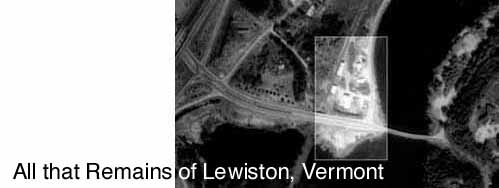
Background
The cluster of buildings across the Connecticut River from Hanover was once a village unto itself. Lewiston stood just on the Vermont side of the Ledyard Bridge and was centered around a rail station that served the area as a crucial transport hub. But over the years Lewiston declined, succumbing to a dramatic death-blow in 1967: bulldozers demolished a number of the burg's remaining buildings for a road-widening project that created a feeder for the new Interstate 91, which passes behind the hills just to the west. Today the village is barely used and much of it is the property of Dartmouth College, which received the land when it purchased the Mary Hitchcock Memorial Hospital in Hanover in the late 1980s. I rely on David H. Story's 1983 Dartmouth geography department paper about Lewiston for this introduction to the village;1 Lewiston's proximity to Dartmouth gives it great future potential and also requires an awareness of its past.
Lewiston lies in Windsor County, Vermont, hard against the state's border with New Hampshire, the west bank of the Connecticut River. The village is a division of the township of Norwich, whose urban center lies invisible over the hills to the west. It is those hills that allowed Lewiston to remain a distinct village on the narrow flats between the hills and the river. Settlers first arrived on the site of Lewiston in 1765, with Dr. Joseph Lewis (1746-1833) arriving two years later. Lewis would become the village's first doctor, and three of his children would attend Dartmouth Medical School.2
Lewiston's site was valuable because it encompassed a brook falling eastward to the Connecticut River south of today's Route 10A. This brook provided a source of power: Dr. Lewis purchased a grist mill and saw mill on the brook in 1793, and other industries also located there as the village grew in the late 18th century: Burton's saw mill arrived in 1800, along with a bark mill, and a tannery with attendant shoemaker. The brook was named Blood Brook for a local family (not for tannery effluents or French and Indian War battles3).
The village also occupied a convenient spot to cross the Connecticut River. Though the village's transport advantages would eventually cause its downfall, for most of its history, transportation nourished the place. The town stood between larger neighbors Hanover and Norwich, both within walking distance. Dr. Lewis ran a ferry to the Hanover side of the river in the late 18th century, and the first bridge to cross at Lewiston came in 1796. The toll bridge coexisted with the ferry, and fell in 1804. New bridges went up in 1806,1839 and 1859, the last being the Ledyard Free Bridge. The covered bridge figures in many photographs of Lewiston and lasted until truck traffic required a steel-and-concrete replacement in 1934 (the New Hampshire and Vermont departments of transportation only replaced this last bridge in 19984).
As transportation networks grew in the nineteenth century Lewiston continued to claim the status as the hub for the area. In 1848 the Passumpsic and Connecticut Railroad laid its tracks through the village as the first line to serve the area. The railroad built a freight depot. Later The Boston & Maine Railroad took over from the P&C, and in 1884 the B&M built the 24 x 54 depot that still stands in the village, now a private club.5 The railroad station was the key to Lewiston's importance and tied the village intimately to Hanover and Dartmouth in particular.
1 2 3 The Village >> |
Click an image below to see a larger version here. No images? View in frames.
1. David H. Story, "The Geography of a New England Ghost Town: Lewiston, Vermont," student paper (1983). In addition to the citations noted below, Story also cites "Last Business Day at Lewiston P.O.," Valley News (30 April 1954), 1; Know Your Town: The 1940 Survey of Norwich, Vermont (Norwich: The Norwich Women's Club, 1942).
2. Mary Lou Perin, "Lewiston, Vermont: The Town That Disappeared," The Valley News (5 November 1983); Story cites M.E. Goddard and Henry V. Partridge, A History of Norwich, Vermont (Hanover, N.H.: The Dartmouth Press, 1905), 270 and Stephanie Greene, "Once Upon a Time There Was a Lewiston," Connecticut Valley Reporter (6 March 1973), 1, 9.
3. Perin wrote that the tannery, the oldest building in Norwich, still stood off Elm Street.
4. John King Lord, History of the Town of Hanover (Hanover: Dartmouth Press, 1928), 31; William Waterman, "The River," in Francis Lane Childs, ed., Hanover: a bicentennial book (Hanover: University Press of New England, 1961), 36.
5. Story cites Boston & Maine Railroad to Mrs. Scott Thomas (25 April 1961), Norwich Historical Society. It is not clear whether the existing freight depot north of the station is the same one built ca. 1848.
©2000 Scott Meacham